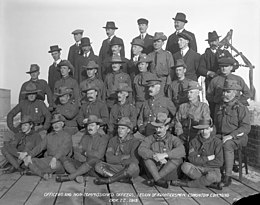Paramilitary
This article needs additional citations for verification. (October 2022) |

A paramilitary is an organization whose structure, tactics, training, subculture, and (often) function are similar to those of a professional military, but is not part of a country's official or legitimate armed forces.[1] Paramilitary units carry out duties that a country's military or police forces are unable or unwilling to handle. Other organizations may be considered paramilitaries by structure alone, despite being unarmed or lacking a combat role.
Overview

Though a paramilitary is, by definition, not a military, it is usually equivalent to a military's light infantry force in terms of strength, firepower, and organizational structure. Paramilitaries use "military" equipment (such as long guns and armored personnel carriers), skills (such as close-quarters combat and bomb disposal), and tactics (such as urban warfare and less-lethal takedowns) that are compatible with their purpose, often combining them with skills from other relevant fields such as law enforcement or search and rescue. They rarely use extensive military equipment, such as artillery and dedicated military aircraft.
During peacetime, paramilitaries are often assigned to protect high-profile sites, such as government facilities, infrastructure, airports, ports, or borders. They may also be tasked with roles of VIP protection or counterterrorism. Depending on the organization the paramilitary operates under, they may also be temporarily reassigned; for example, members of a police tactical unit may be assigned to patrol officer duties until they are needed again.
A paramilitary may fall under the command of a military, train alongside them, or be authorized to use their resources, despite not actually being part of them.
Legality
Under the law of war, a state may incorporate a paramilitary organization or armed agency (such as a law enforcement agency or a private volunteer militia) into its combatant armed forces. The other parties to a conflict have to be notified thereof.[2]
Some countries' constitutions limit freedom of association by prohibiting paramilitary organizations outside government use. In most cases, there is no definition of paramilitary, and court decisions are responsible for defining that concept.
Types

Depending on the definition adopted, "paramilitaries" may include:
Military organizations
- Irregular military forces, such as militias, resistance movements, guerrillas, insurgents, and terrorists
- Private military company and mercenary forces
- The auxiliary forces of a state's military or government, such as national guard, presidential guard, republican guard, state defense force, civil air patrol, home guard, royal guard, and imperial guard forces
- Volunteer Defence Corps, such as Volunteer Defence Corps in Thailand, Volunteer Defence Corps in Australia, Shanghai Volunteer Corps, and Royal Hong Kong Regiment
Political
- Armed, semi-militarized wings of existing political parties:
- the Italian Fascist Party's Voluntary Militia for National Security
- Weimar paramilitary groups, belonging to political parties in the Weimar Republic:
- the Nazi Party's Sturmabteilung and Schutzstaffel
- the Monarchist German National People's Party's Der Stahlhelm
- the Communist Party of Germany's Parteiselbstschutz
- Sinn Féin's Irish Republican Army
- Hamas' Izz ad-Din al-Qassam Brigades
- African National Congress' UMkhonto we Sizwe
- The Hindu nationalist group Rashtriya Swayamsevak Sangh
Law enforcement
- Semi-militarized law enforcement units within civilian police forces, such as police tactical units, SWAT teams, Emergency Service Units, and incident response teams
- Gendarmeries, such as the Dutch Royal Marechaussee, Egyptian Central Security Forces, European EUROGENDFOR, Turkic TAKM, and Chilean Carabineros de Chile
- Border guards, such as Australian Border Force, India's Border Security Force, Bangladesh's Border Guards Bangladesh and Turkey's village guards
- Internal Troops
- Security forces of ambiguous military status, such as internal troops, railroad guards, or railway troops
- Branches of federal agencies tasked with law enforcement or security operations:
- CIA Special Activities Center Special Operations Group and Global Response Staff
- Branches of the American FBI, DEA, ATF, and ICE, among other federal agencies
- Federal Protective Forces
- NASA Emergency Response Teams
Civil defense
- The fire departments of many countries are often organized in a manner similar to military or police forces despite being unarmed
- Belgian Civil Protection
- Singapore Civil Defence Force
- Australian State Emergency Service
- Ukrainian Territorial Defense Forces
- Lithuanian Riflemen's Union
Examples of paramilitary units
See also
- Category:Rebel militia groups
- International Association of Gendarmeries and Police Forces with Military Status
- List of Serbian paramilitary formations
- Militarization of police
- Fourth-generation warfare
- Violent non-state actor
- Military urbanism
- Guerrilla warfare
- List of countries by number of military and paramilitary personnel
References
- ^ "paramilitary". Oxford English Dictionary (3rd ed.). Oxford University Press. June 2011 [online edition; original published in June 2005]. Retrieved 2011-09-13.
Designating, of, or relating to a force or unit whose function and organization are analogous or ancillary to those of a professional military force, but which is not D regarded as having professional or legitimate status.
- ^ "Customary IHL - Section B. Incorporation of paramilitary or armed law enforcement agencies into armed forces". Icrc.org. Retrieved 2013-07-27.
Further reading
- Golkar, Saeid. (2012) Paramilitarization of the Economy: the Case of Iran's Basij Militia, Armed Forces & Society, Vol. 38, No. 4
- Golkar, Saeid. (2012). Organization of the Oppressed or Organization for Oppressing: Analysing the Role of the Basij Militia of Iran. Politics, Religion & Ideology, Dec., 37–41. doi:10.1080/21567689.2012.725661
- Üngör, Uğur Ümit (2020). Paramilitarism: Mass Violence in the Shadow of the State. Oxford University Press. ISBN 978-0-19-882524-1.
